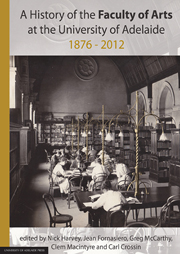Book contents
- Frontmatter
- Contents
- List of Contributors
- 1 The Faculty of Humanities and Social Sciences and the BA Degree at the University of Adelaide since 1876
- 2 Webs of Significance: an Ethnographer's Account of Anthropology at the University of Adelaide from 1973 to 2011
- 3 The History of the Centre for Asian Studies at the University of Adelaide
- 4 Classics at the University of Adelaide (1874–2012)
- 5 English and Creative Writing: ‘the abode of … literature; the home of poetry and fiction’
- 6 A Tale of Resilience: the History of Modern European Languages at the University of Adelaide
- 7 Geography, Environment and Population at the University of Adelaide, 1904–2012
- 8 Gender Studies and Social Analysis
- 9 History
- 10 The History of Aboriginal Languages and Linguistics at the University of Adelaide
- 11 The Digital, Participatory and International Turn: Media at the University of Adelaide
- 12 Musical fusions
- 13 Philosophy at the University of Adelaide
- 14 Politics at the University of Adelaide
- Appendices
3 - The History of the Centre for Asian Studies at the University of Adelaide
Published online by Cambridge University Press: 05 June 2013
- Frontmatter
- Contents
- List of Contributors
- 1 The Faculty of Humanities and Social Sciences and the BA Degree at the University of Adelaide since 1876
- 2 Webs of Significance: an Ethnographer's Account of Anthropology at the University of Adelaide from 1973 to 2011
- 3 The History of the Centre for Asian Studies at the University of Adelaide
- 4 Classics at the University of Adelaide (1874–2012)
- 5 English and Creative Writing: ‘the abode of … literature; the home of poetry and fiction’
- 6 A Tale of Resilience: the History of Modern European Languages at the University of Adelaide
- 7 Geography, Environment and Population at the University of Adelaide, 1904–2012
- 8 Gender Studies and Social Analysis
- 9 History
- 10 The History of Aboriginal Languages and Linguistics at the University of Adelaide
- 11 The Digital, Participatory and International Turn: Media at the University of Adelaide
- 12 Musical fusions
- 13 Philosophy at the University of Adelaide
- 14 Politics at the University of Adelaide
- Appendices
Summary
INTRODUCTION
In September 2011, Prime Minister Julia Gillard announced a White Paper, Australia in the Asian Century, declaring that ‘the shift of economic and strategic weight to Asia has never been more rapid or profound for Australia's interests than it is now’. A key aim of the enquiry is to seek ways of ‘deepening engagement’ with Asia. At the beginning of 2012, first semester enrolments at the Centre for Asian Studies (‘CAS’ or ‘Centre’) totalled almost 1500 students across twenty courses, coordinated and taught by twelve full-time academics assisted by thirteen casual and contract staff. In addition, there were five honours students and fourteen postgraduates. The Centre should be well placed to help achieve the goals enunciated in the White Paper. Total enrolments for each semester of 2011 had exceeded 1200. These figures also represent by far the largest generator of international fee-paying student revenue in the Faculty of Humanities and Social Sciences (‘HUMSS’ or ‘Faculty’) though only a minority of the fee-paying students are enrolled in HUMSS degrees. This is a very different situation from 1975, the year the Centre's combined language and social science courses saw four full-time staff teach 104 students. It is unlikely that there was even one international student in 1975 and there were only a few from outside the Faculty. These statistics reflect dramatic shifts not only within the Centre, but in Australia's university sector generally, particularly in the attitudes of students and institutions towards the study of Asia and its languages.
- Type
- Chapter
- Information
- A History of the Faculty of Arts at the University of Adelaide1876-2012, pp. 51 - 80Publisher: The University of Adelaide PressPrint publication year: 2012



